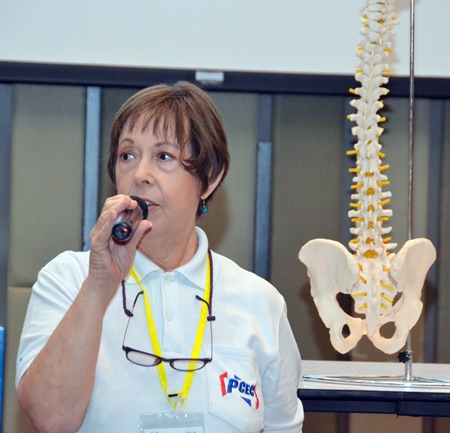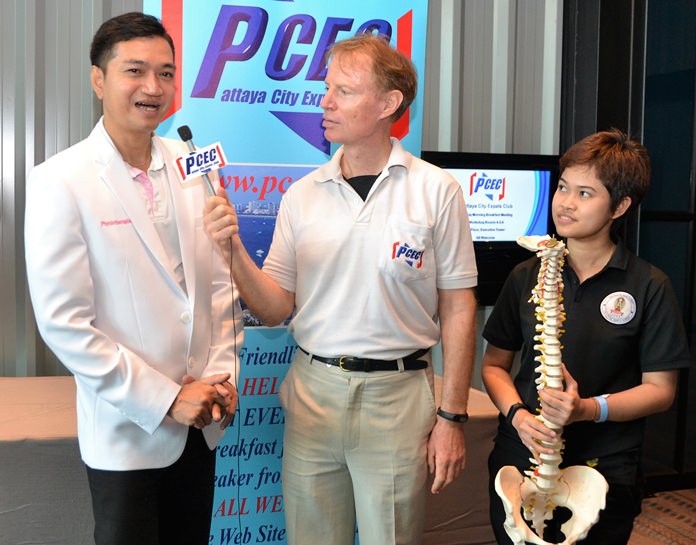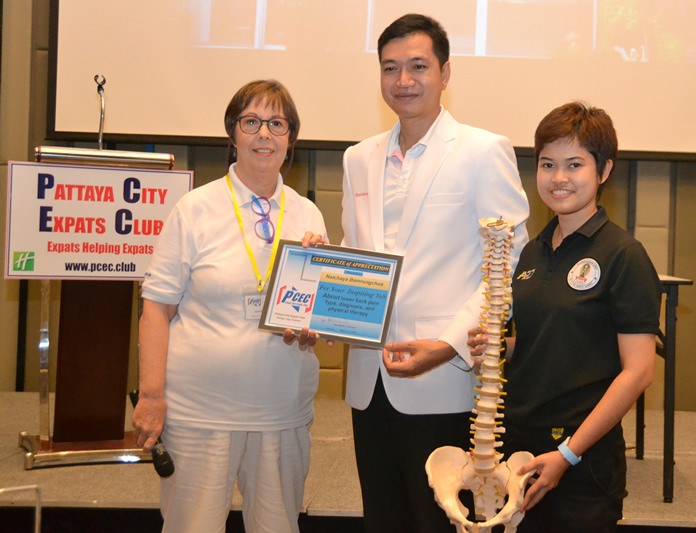
Causes and treatment of lower back pain was the topic for the Pattaya City Expats Club at their regular Sunday morning on March 11, 2018. Physiotherapist Natchaya Bamrungchua was the guest speaker. His topic focused on lower back pain – a common problem among retired expats. He divided his talk into three areas: types of problems, diagnosis, and physical therapy management including exercise. He operates the Royal Physiotherapy Clinic on Pattaya 3rd road across from Tony’s gym.
 Natchaya has a comprehensive background in physiotherapy with a B.Sc. Physiotherapist, from Rangsit University, a Master of Sports Science from Chulalongkorn University in Thailand, and an MBA from Stamford International University. He is a Certified Mulligan Practitioner (Australia concepts), and holds a Grad certification in Orthopedic Manual Therapy from Curtin University, WA, Australia. In addition, he has Certification in Muscle Energy technique from the University of Oxford, UK.
Natchaya has a comprehensive background in physiotherapy with a B.Sc. Physiotherapist, from Rangsit University, a Master of Sports Science from Chulalongkorn University in Thailand, and an MBA from Stamford International University. He is a Certified Mulligan Practitioner (Australia concepts), and holds a Grad certification in Orthopedic Manual Therapy from Curtin University, WA, Australia. In addition, he has Certification in Muscle Energy technique from the University of Oxford, UK.
He said there are two types of LBP (lower back pain), non-specific and specific. Some 85% of LBP is of the non-specific kind and is caused by improper posture or movements. These can usually be managed through physical therapy. Specific back pain is usually caused by a neural disorder or disc degeneration; the latter being prevalent in the aging generation. There are 4 stages of disc degeneration, the most serious of which is Sequestration which always requires surgery. The compression of the spinal disc causes it to ooze or protrude out of its place putting pressure on the spinal nerve bundle leading to various degrees of pain or discomfort. X-rays can help identify and locate a damaged disc.
Sciatic nerve compression is a common cause of pain in the lower back accompanied with various leg discomfort problems. There are several muscle groups surrounding the ‘sciatic notch’ through which the spinal cord branches out into the leg. Improper posture and extreme sport extensions of the hip joint regularly affect this area.
Natchaya pointed out in pictorial form the 4 types of improper posture which included sway back (hips thrust forward), Lumbar Lordosis (chest out, butt out), Thoracic Kyphosis (humped shoulder) and face forward. Each of these out of normal postures can generate various degrees of back discomfort. Pelvic misalignment can be associated with any of these posture positions. All of these conditions can be further aggravated by muscle weakness in the hip area.

So what are the treatments? They can vary by situation but generally physical therapy treatments include Pain relief (Ultrasound therapy, TENS, heat therapy, manipulation, mobilization, traction, massage therapy), Muscle relaxation, Tension relief, Nerve stretching, Exercise and strengthening programs and Home exercise and advice. Any or all of these may be required if one expects to return to his or her normal athletics routines. For extreme cases as mentioned above, surgery may be the only option.
Natchaya with the aid of an assistant demonstrated various home exercises that could be done to reduce lower back pain. Among these were pelvic tilting, general back exercises, stretching, muscle strengthening and core strengthening.

Most of the questions fielded by Natchaya related to personal situations and each one was addressed with some valuable advice. The therapist may have won himself some new patients as he seemed well informed and verbalized his answers and talk well.
MC Judith Edmonds then brought everyone up to date on current events. This was followed by the “Open Forum” portion of the meeting, where questions are asked and answered and comments made about expat living in Thailand. For more information on the Club and their activities, visit www.pcec.club.








